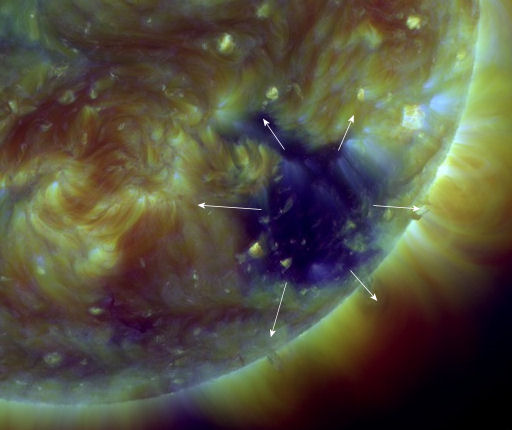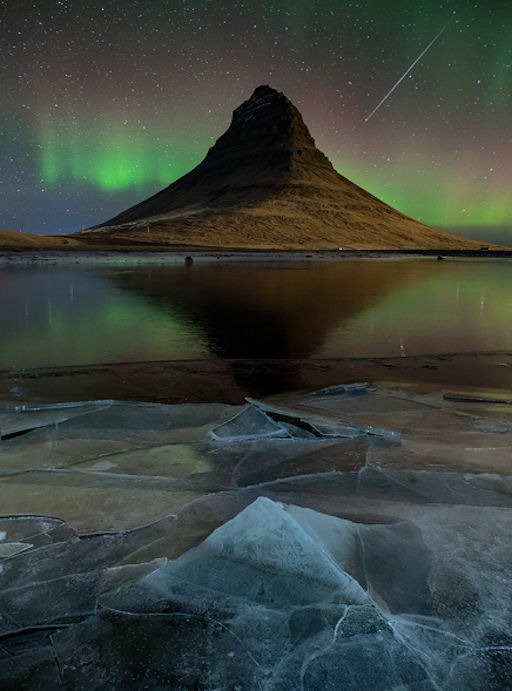LUNAR IMPACTS TODAY: NASA's twin lunar gravity probes, nickhamed Ebb and Flow, will collide with a mountain near the Moon's north pole today, Dec. 17, at 5:28 pm EST. Get the full story from Science@NASA.
SOLAR WIND: Earth is entering a stream of high-speed solar wind. The source of the wind, a coronal hole on the sun, is shown in this image taken by NASA's Solar Dynamics Observatory during the early hours of Dec. 17th:
A coronal hole is a place in the sun's atmosphere where the solar magnetic field opens up and allows solar wind to escape. This particular coronal hole is located far down in the sun's southern's hemisphere, so the stream it is emitting is not heading directly for our planet. To some degree, this will mitigate its impact on Earth. At the moment, NOAA forecasters are estimating a relatively slight 20% chance of geomagnetic storms. Nevertheless, high-latitude sky watchers should be alert for auroras. Aurora alerts: text, voice.
Realtime Space Weather Photo Gallery
GEMINID METEOR RECAP: Earth has exited the debris stream of rock comet 3200 Phaethon, which brings an end to the annual Geminid meteor shower. On peak night, Dec. 14th, worldwide observers counted more than 100 meteors per hour, many of them fireballs (meteors brighter than Venus). David Clapp photographed this one streaking over the icy waters of Kirkjufell, Iceland:
"This was one amazing moment," says Clapp.
Note: Although the meteor appears to be flying mostly-above the auroras, it is more likely below. Geminid meteors burn up approximately 80 km above Earth's surface, while auroras stretch from 100 km to 500 km high.
Pictures of Geminids are still pouring in. Browse the photo gallery to see the most popular photos submitted so far:

![]()
Solar wind
speed: 451.1 km/sec
density: 7.6 protons/cm3
explanation | more data
Updated: Today at 1937 UT
![]()
X-ray Solar Flares
6-hr max: C1 1502 UT Dec17
24-hr: C1 1502 UT Dec17
explanation | more data
Updated: Today at: 1900 UT
![]()
![]()
![]()
Daily Sun: 17 Dec 12
![]()
![]()
None of the spots on the Earthside of the sun is actively flaring. Credit: SDO/HMI
![]()
![]()
![]()
Sunspot number: 74
What is the sunspot number?
Updated 17 Dec 2012
Spotless Days
Current Stretch: 0 days
2012 total: 0 days (0%)
2011 total: 2 days (<1%)
2010 total: 51 days (14%)
2009 total: 260 days (71%)
Since 2004: 821 days
Typical Solar Min: 486 days
Update 17 Dec 2012
The Radio Sun
10.7 cm flux: 122 sfu
explanation | more data
Updated 17 Dec 2012
![]()
![]()
![]()
Current Auroral Oval:
![]()
Switch to: Europe, USA, New Zealand, Antarctica
Credit: NOAA/POES
![]()
![]()
![]()
Planetary K-index
Now: Kp= 2 quiet
24-hr max: Kp= 4 unsettled
explanation | more data
![]()
Interplanetary Mag. Field
Btotal: 7.8 nT
Bz: 4.1 nT north
explanation | more data
Updated: Today at 1937 UT
![]()
![]()
![]()
Coronal Holes: 17 Dec 12
![]()
![]()
Earth is entering a stream of solar wind flowing from the indicated coronal hole. Credit: SDO/AIA.






